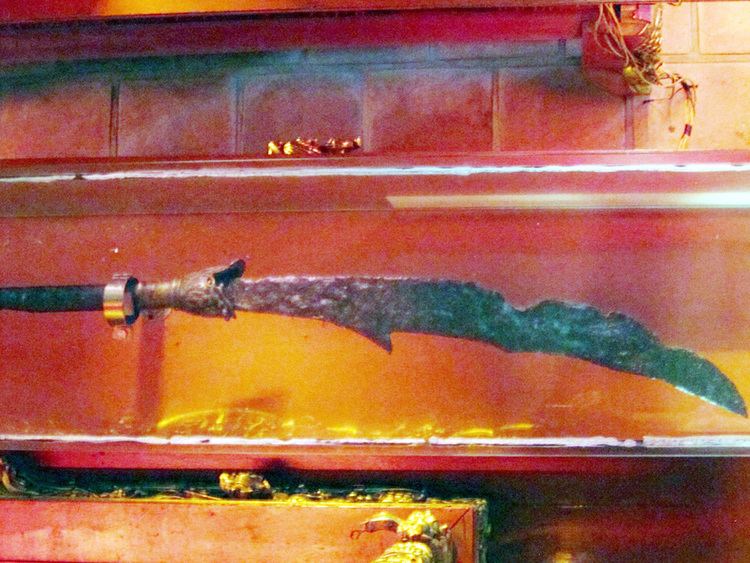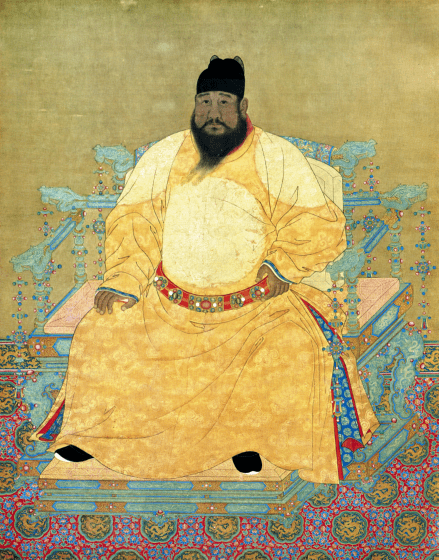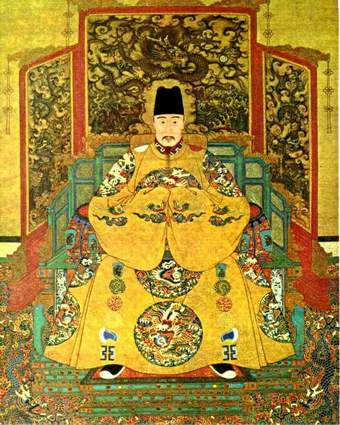Reign 15 June 1527-1529 Spouse Nguyễn Thị Ngọc Toàn Mother Đặng Thị Hiếu Parents Mạc Hịch | Father Mạc Hịch House Mạc dynasty | |
Children Mạc Thái Tông, Mạc Chính Trung Similar Mạc Thái Tông, Trịnh Kiểm, Mạc Đĩnh Chi, Trịnh Tùng, Nguyễn Hoàng | ||
Tha i t m c ng dung vi nh n l p qu c
Mạc Đăng Dung (chữ Hán; 莫登庸; 1483?–1541), posthumous name Mạc Thái Tổ (莫太祖), was an emperor of Vietnam and the founder of the Mạc Dynasty. Previously a captain of the imperial guard (Praetorian Prefect equivalent) of one of the Lê Dynasty emperors, he gradually rose to a position of great power. Mạc eventually deposed the last Lê monarch and became a monarch himself.
Contents
- Tha i t m c ng dung vi nh n l p qu c
- Huy n ki n th y qu h ng vua m c ng dung m nh t n i u s ng
- From bodyguard to emperor
- Emperor Minh c
- Retirement and rule again
- References

Huy n ki n th y qu h ng vua m c ng dung m nh t n i u s ng
From bodyguard to emperor

The Ming's ethnic Vietnamese collaborators included Mac Thuy, whose grandfather was Mạc Đĩnh Chi, who was a direct ancestor of Mạc Đăng Dung.

He was born Mạc Đăng Dung (莫登庸) on 23 November 1483 (Quý Mão in the sexagenary cycle) at the village of Cổ Trai, Nghi Dương district (modern Kiến Thụy, part of Haiphong city) as a fisherman's son.

Mạc Đăng Dung got his start as a bodyguard to the cruel and depraved monarch of Vietnam, Lê Uy Mục. Mạc Đăng Dung was famous for his strength and cunning. (For more information see the article on the Lê Dynasty). Note that while some sources claim Mạc Đăng Dung was a Confucian scholar (government administrator) this seems to be the result of confusion with another notable Vietnamese scholar whose family name was also Mac. Mạc Đăng Dung was a military man who rose through the ranks.

Despite several assassinations (both Lê Uy Mục and his successor Lê Tương Dực were assassinated) Mạc Đăng Dung continued to gain power and rank in the military. With the enthronment of the young emperor Lê Chiêu Tông in 1516, a power struggle in the court ensued. On the one side was Mạc Đăng Dung and his supporters (Mac was now the top general of the armies of Vietnam). On the other side were two noble families of Vietnam, the Trịnh and the Nguyễn, led by Nguyễn Hoàng Du and Trịnh Duy Dai and Trịnh Duy Sản.
Around 1520, the power struggle broke into civil war. The young emperor fled south to Thanh Hóa Province along with the Trịnh and the Nguyễn families. Mạc Đăng Dung soon proclaimed that the king's younger brother, Prince Xuan, was now the true monarch of Vietnam and had him installed under the name Lê Cung Hoàng. Meanwhile, armies fought along the border of Thanh Hóa Province.
In 1524, forces loyal to Mạc Đăng Dung captured and executed the original emperor Lê Chiêu Tông along with the leaders of the revolt (Nguyễn Hoàng Du, Trịnh Duy Dai, and Trịnh Duy Sản). The revolt by the Trịnh and the Nguyễn was defeated for the moment.
Emperor Minh Đức
Three years later, in 1527, Mạc Đăng Dung removed and killed his figurehead lord and proclaimed that now he was the emperor of Vietnam under the name Minh Đức. Using ruthless methods, he forced the Lê officials to recognize his dynasty and he murdered the members of the Lê family who still remained in the north. Some government officials committed suicide rather than acknowledge Mạc Đăng Dung as emperor, but others fled south and joined the resistance.
Yet another rebellion was launched, this time under the leadership of Nguyễn Kim and his son-in-law Trịnh Kiểm. Appeals from the Trịnh and Nguyễn were made to the Chinese Ming court to send in an army to remove the usurper. However Mạc Đăng Dung, using submissive behavior and bribery, managed to obtain a temporary recognition of his rule from the Ming dynasty in 1528.
The murder of the Lê emperor provoked unrest and the Trịnh and the Nguyễn revolted against the rule of Mạc Đăng Dung. Nominally the Trịnh and the Nguyễn were fighting on behalf of another Lê emperor, Lê Trang Tông, but in reality, he (and all future Lê monarchs) had no power.
In 1529 Mạc Đăng Dung abdicated in favor of his son, Mạc Đăng Doanh, thus establishing his dynasty.
Retirement and rule again
Mạc Đăng Dung lived on as a retired emperor while his son had to deal with the continuing revolt by the Trịnh and the Nguyễn. His son was not the equal of his father and as a result of several defeats, he lost control of the provinces south of the Red River. In 1533, the Nguyễn-Trịnh army conquered the Winter Palace and proclaimed Lê Trang Tông the rightful ruler of Vietnam.
Adding to the problems of military defeats, an official Chinese delegation determined that Mạc Đăng Dung's usurpation was not justified and so, in 1537 a very large army was dispatched to Vietnam under the pretense of restoring the Lê family to power. In the summer, with the Chinese invading the north, Dung's son Doanh died and so Dung resumed his former position as emperor.
The Ming Chinese threatened Mạc Đăng Dung with an invasion of 110,000 men ready to invade Vietnam from Guangxi in 1540. Mac succumbed and caved in to Chinese pressure and accepted the bitter demands the Chinese made, including crawling barefoot in front of the Chinese, giving up land to China, downgrading the status of his polity from a country to a chieftaincy and giving up official documents like tax registers to the Ming. The Chinese accepted him as ruler over a part of Vietnam while he claimed to accept Lê rule over the southern part of Vietnam. But the Nguyễn and the Trịnh refused to accept this division and so the war continued in the south.
Mạc Đăng Dung died in 1541 and de facto authority was transferred to his grandson Mạc Hiến Tông.
Despite the Chinese recognition and his rule over much of Vietnam, later Vietnamese historians question the legitimacy of his reign. The usurpation by Mạc Đăng Dung split the kingdom, with the Mạc Dynasty reigning in the north, and the Lê Dynasty continuing in the south, supported by the Trịnh lords and the Nguyễn Lords.
